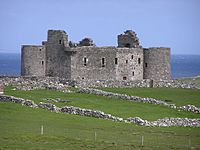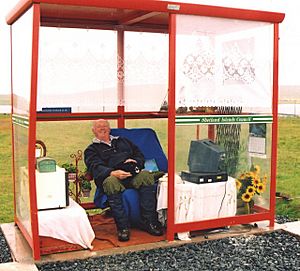Unst facts for kids
| Norse name | Ǫmstr |
|---|---|
| Meaning of name | Possibly pre-Celtic |
| OS grid reference | HP600091 |
| Coordinates | 60°45′N 0°53′W / 60.75°N 0.88°W |
| Physical geography | |
| Island group | Shetland |
| Area | 120.68 km² |
| Area rank | 14 |
| Highest elevation | Saxa Vord, 284 m (932 ft) |
| Administration | |
| Sovereign state | United Kingdom |
| Country | Scotland |
| Council area | Shetland Islands |
| Demographics | |
| Population | 632 |
| Population density | 5.2 people/km2 |
| Largest settlement | Baltasound |
Unst is one of the North Isles of the Shetland Islands in Scotland. It is the most northern island in the British Isles where people live. Unst is the third-largest island in Shetland. Only the Mainland and Yell are bigger. The island covers an area of about 46 square miles (120 km2).
Unst is mostly covered in grassland and has tall cliffs along its coast. Its main village is Baltasound. This village was once an important fishing port. Today, it has a fun leisure centre and the island's airport. Other villages include Uyeasound, where you can see an old warehouse called Greenwell's Booth. Muness Castle is also nearby, built in 1598. In Haroldswick, you can visit a boat museum and a heritage centre.
Contents
What Does the Name Unst Mean?
The names of three Shetland islands, Unst, Fetlar, and Yell, are very old. We don't know exactly where they came from. They might be older than the Pictish or Norse languages.
The Norse people, who lived here long ago, gave these names their own meanings. For example, Ǫmstr meant "corn-stack." But these meanings don't seem to fit the islands very well. This suggests the names were changed from an even older language.
Unst Through History
Unst has a rich history, especially from the Vikings. The "Viking Unst" project has explored many old Viking sites. They have dug up parts of three longhouses. There are about 60 such longhouses known on the island. You can even see a copy of a Viking ship called Skibladner in Haroldswick.
Before the 12th century, Christian chapels were built on Unst. St Olaf's Chapel at Lund and Our Lady's Kirk at Framgord are examples. You can still see old gravestones there. Some are shaped like crosses, and others are like the keel of an upside-down ship. These are called "keelstone" markers.
James Hepburn, 4th Earl of Bothwell visited Unst in 1567. He was involved in a sea battle near the island. Later, in 1598, Laurence Bruce built Muness Castle. Pirates attacked the castle in 1627.
A famous minister, Rev Dr James Ingram, lived on Unst. He was a minister from 1821 and lived to be 103 years old! His father and grandfather also lived for over 100 years.
Robert Louis Stevenson, who wrote Treasure Island, visited Unst. His father and uncle helped design the Muckle Flugga lighthouse. Some people believe Unst was the inspiration for the map in Treasure Island.
In the 1950s, a researcher named Erving Goffman studied life on Unst. His work helped him write a famous book called The Presentation of Self in Everyday Life.
On January 7, 2007, Unst experienced an earthquake. It measured 4.9 on the Richter scale. This was one of the strongest earthquakes in the Norwegian Sea area in 10 years.
Geography and Geology of Unst
Unst is famous for its "most northerly" places in the UK. Skaw is the northernmost village. Haroldswick has Britain's most northerly church. The Muckle Flugga lighthouse is the UK's most northerly lighthouse. It opened in 1858. Just beyond it is Out Stack, the most northerly rock in the UK.
Western Norway is only about 300 kilometres away from Unst.
The rocks on Unst and Fetlar are mostly ultramafic and mafic igneous rocks. These rocks are thought to be part of an ophiolite. An ophiolite is a piece of oceanic crust from an ancient ocean called the Iapetus Ocean. This ocean disappeared during a mountain-building event called the Caledonian orogeny.
Unst also had several chromite quarries in the past. From 1907 to 1937, a railway called the Hagdale Chromate Railway served one of these quarries. A special mineral called theophrastite was found at Hagdale in 1960.
Economy and Getting Around Unst
Ferries connect Belmont on Unst to Gutcher on Yell and Oddsta on Fetlar.
A unique feature of Unst is the Unst Bus Shelter. It's also known as Bobby's Bus Shelter. This bus stop near Baltasound is special because it has home comforts. It even has a television! Local people take care of it.
Unst is also home to the Promoting Unst Renewable Energy (PURE) project. This project uses wind power to create hydrogen. It's a community-owned clean energy system. The Pure Energy Centre was created from this project. It now installs hydrogen systems in many places.
At the southern end of Unst, near the ferry terminal, is Belmont House. This beautiful house was built in 1775. It has been called "possibly the most ambitious, least-altered classical mansion in the Northern Isles." A charity restored it between 1996 and 2010. Now, it can be rented for events.
In 2011, the population of Unst was 632 people. This was a small drop from 720 people in 2001.
In 2016, the island was featured on a BBC Two TV show called An Island Parish.
Saxa Vord and Space Centre
The Saxa Vord Royal Air Force radar station closed in 2006. This meant over 100 jobs were lost.
In 2007, a businessman bought the old RAF Saxa Vord site. He renamed it "Saxa Vord Resort." He turned the base into a tourist resort. It now has self-catering holiday homes, a bunkhouse, a restaurant, and leisure facilities. Local businesses like Unst Cycle Hire and Valhalla Brewery have moved there.
In 2017, the Shetland Space Centre Ltd was started. They suggested that Lamba Ness on Unst would be a good place to launch rockets. These rockets would carry satellites into orbit. In 2020, the UK Space Agency approved the idea. Lockheed Martin also plans to use the site for rocket launches. In 2021, plans were submitted to build three rocket launch pads.
Wildlife on Unst
Unst is an important place for seabird colonies. You can find many birds at the Hermaness National Nature Reserve. The island is also known for its special plants. These include the Norwegian sandwort and the Shetland Mouse-ear. The Shetland Mouse-ear is found only on Unst.
A large seabird called the Great skua is common on the island. Local people call it the "bonxie."
See also
 In Spanish: Unst para niños
In Spanish: Unst para niños



